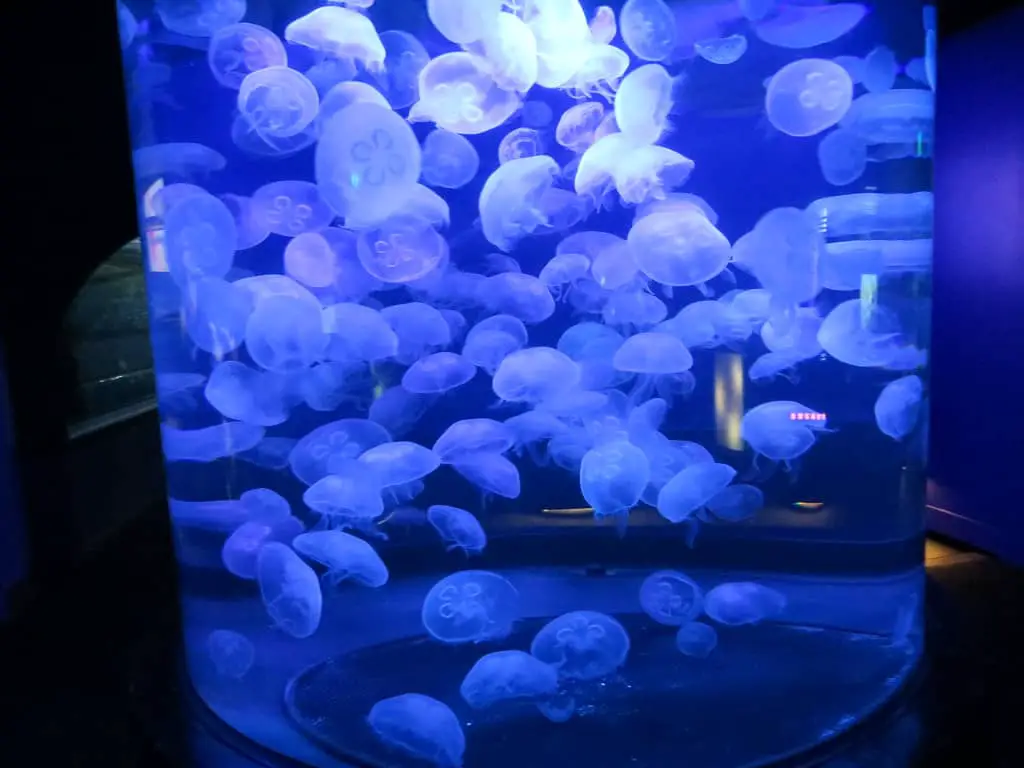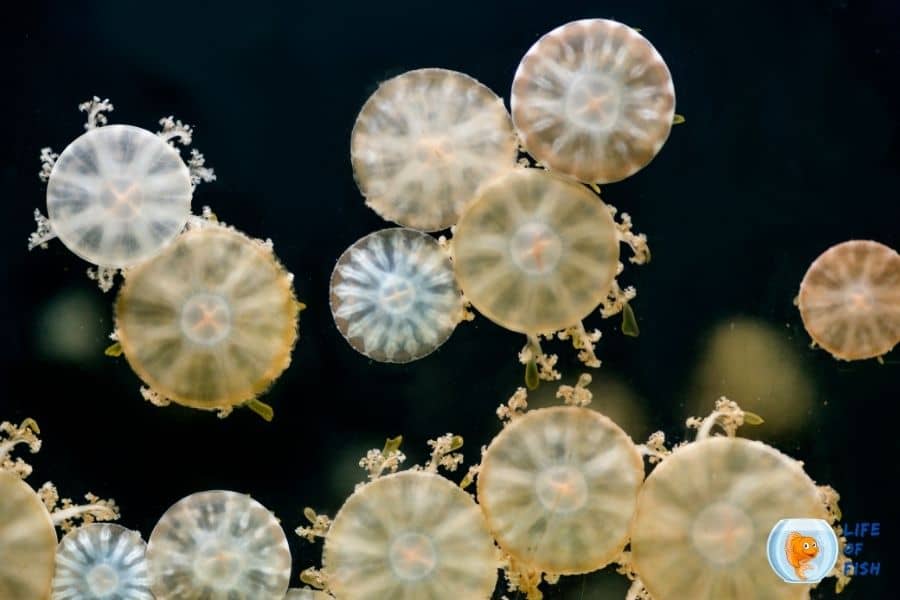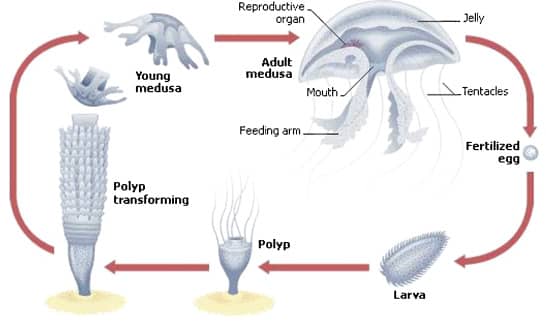Moon Jellyfish Breeding usually does not have an exact time frame, and they breed a full year around. But there might be few pauses in between due to the environment; reproduction of the moon jellyfish happens when Medusa becomes maturation sexually, typically occurring during the summer and autumn months for 2-3 months.

Unlike in the wild, Moon Jellyfish Breeding, these species in captivity require a lot of patient and effort alongside the proper setup and technique.
With this article, you will learn how to breed your moon jellyfish at your home with more pro techniques and education on the requirements that need to reproduce these species.
Understand their life cycle.
Jump To
- 1 Understand their life cycle.
- 2 Do They Die
- 3 What is the lifespan of a jellyfish?
- 4 Are there male and female Jellyfish?
- 5 How Sexual reproduction of moon jellyfish happens in nature.
- 6 Do moon jellyfish reproduce in captivity?
- 7 How do Moon Jellyfish Breeding?
- 8 Can Moon Jellyfish Breeding aquarium
- 9 Related Questions
- 10 Source
Eggs
Moon jellyfish usually receive the sperms through the mouth, and eggs fertilize internally. The eggs are then brooded in the moon jellyfish’s oral arm till they hatch into a tiny slipper-shaped larva.
Planula Larva
Sperms and eggs combine to produce a larva, called planula; using cilia on its body, tiny moving hairs, the planula larva can swim around searching for an ideal place to settle. Typically, these locations are somewhere dark, upside down, with a shallow current.
Polyps
Once settled, planula will evolve into a polyp that uses its tentacles to catch its food, tiny organisms, and waste floating in the water.
Scyphistoma
Stage asexually buds off young medusae from its top end. And with these ephyrs growing into adults, either male or females.
Ephyra
These are generally known as free-swimming jellies. It will be the stage before evolving into a medusa.
Medusa
The stage in which you can see the moon jellyfish can reproduce. For example, Medusa has a bell and tentacles and would drift along the surface of the water.
Do They Die
Usually, a jellyfish’s life span is entirely dependent on which stage it is. For example, the polyp may live for up to 25 years in an aquarium setting, and a mature moon jellyfish that is sexually producing does not live a long life. So for Jellyfish, sex is a sign that they will die.
What is the lifespan of a jellyfish?
Moon jellyfish have a very average life span between 8 to 12 months.
Are there male and female Jellyfish?
Yes. Jellyfish do have their separate sexes. You can identify a female jellyfish for its less dense gonad tissue, where you can see through the folds of the ovaries. And a male jellyfish, you can see the tissues outside of those rings.
How Sexual reproduction of moon jellyfish happens in nature.
A typical jellyfish does its reproduction by releasing sperms and eggs into the water, where the eggs fertilize. But when it comes to a moon jellyfish, the process changes.
Rather than releasing the sperms and the eggs out, these species do it differently, where the male moon jellyfish releases its sperms and the female moon jellyfish receives it via its mouth or the oral arm.
The eggs will be fertilized inside the female moon jellyfish and incubate the eggs in arm pockets till they change into planula or jellyfish larva, where after she would release them to the water.

Do moon jellyfish reproduce in captivity?
Yes, Moon jellyfish do reproduce in captivity like any aquatic animal, but this is a challenging and lengthy process.
How do Moon Jellyfish Breeding?
Considering these species’ life cycles, the last thing that comes to anyone’s mind is how I can breed these Jellyfish? Moon Jellyfish have a combination of sexual and asexual reproduction.
Sexual reproduction in captivity needs plenty of space and proper planning, yet; it is almost impossible to reproduce moon Jellyfish in captivity through sexual reproduction.
The one we can try at home is asexual reproduction. In asexual reproduction, moon Jellyfish polyp asexually buds off several clones of itself and swim away as medusae. These medusae eventually become sexually matured moon jellies.
If you pre-own Jellyfish sometimes, you might not even see some of its stages in its cycle, where you might begin to find polyps in your jellyfish tank.
You might think about how you can find these ephyrae on occasion. Suppose you have ever visited a jellyfish aquarium or a jellyfish public aquarium.
In that case, you might have noticed few tiny Jellyfish that have been bred naturally in the tank itself without even knowing it.
This process can even happen at your home jellyfish tank. But again, the question that arises is that you may find yourself without Jellyfish or with only one gender jellyfish.
Getting your Jellyfish or polyps
It is common for the breeder to start at the polyp stage of the jellyfish life cycle. These tiny creatures are small yet visible and reproduce to keep their population alive, making them highly stable.
In addition, these polyps can be transported or even shipped and sold relatively quickly, making this stage a great place to start your Moon Jellyfish Breeding.
To start, you must get hold of some polyps. Sometimes you might find these in your jellyfish tank. In case you find these in your tank, scrape or suck a few off and put them in a covered dish, culture dish, petri dish, or small aquarium, etc.
Always keep in mind that there has to be enough room for them to bud off and enough water to prevent fouling in 24 hours.

Next, cover the vessel and leave the polyps in there. Covering prevents the water from evaporating and altering the salinity; hence, it advises covering. You can use an incubator or a heater, but for moon jellyfish polyps, room temperature is satisfactory.
If you do not have any polyps, you must buy some from a dealer of Jellyfish or grow them from planula. Buying polyps are easy, but considering the price, they are very expensive and unpredictable due to stocking issues.
Also, remember that growing them from planula is not easy, but we will discuss developing your polyps from a planula.
How to grow Polyps from Planula?
You can generally do two things when trying to grow polyps from planula. The first way is to buy some jellyfish and suck planula from the corners of the shipping bags.
A planula is commonly collected. Always remember that planulas are very hard to see, or the second method is to dissect gonads out of several Jellyfish and put them in a dish together.
Once you have collected and confirmed after checking them under a microscope, you can start to grow your polyps. You must now put your planula in a proper jellyfish tank or an appropriate cover of the dish and keep it for around 7 to 10 days.
Also, check whether you can see any early polyp developments. After completing the required days, check for the polyp again, without removing the cover, and if you still don’t see any signs of polyps, keep it for another five or more days, whereby you should have polyps. If not, you will have a tank or dish filled with dead planula.
Therefore, we always recommend you put your planula in a tank rather than a dish.
Reasons to be is in a tank you have temperature-controlled water and a well set up environment, providing food, waste removal, and other essential elements that are hard to achieve from a dish.
Now that you have achieved getting the polyps, you can start the process to produce Jellyfish. You have to consider a few crucial things now that would determine whether or not your Jellyfish live.
If they live in a dish, it is safe, but you have to be very cautious if they live in a tank. Because when polyps produce ephyra in a tank with time, you might see hundreds of ephyra in your tank for Moon Jellyfish Breeding.
What are you feeding the polyp, and what will you feed the ephyra?
We recommend feeding your polyp and ephyra with live decapsulated brine shrimp and liquid invertible reef food, which you can get from any pet store.
However, you must only use decapsulated brain shrimps as regular brine shrimp eggs will foul the water and sometimes produce new organisms into your tank that might even kill or harm your polyp and ephyra.
Where to keep your ephyra
We highly advise using Petri dishes, glass cups, or Tupperware containers, as the flow is unnecessary for the ephyra but always keep in mind that you have to change the water every day.
If you own a Kreisel jellyfish tank, you might be able to save your ephyra in there, but it is more likely to be blended, so it is always best to use a dish or a container with still water and provide them with food daily and change their water daily.
How are ephyra produce
Polyp reacts to high levels of iodine and high temperature. So it will eventually start to make those stacks of Jellyfish.
You can tempt them into doing this by raising the temperature in your tank up to few degrees, or if you have polyps in a dish, you can add 1 to 2 drops of Lugol’s iodine or perhaps invertebrate food that contains iodine.
Where then, your polyp will start to stacks of 5 to 12 ephyra. These creatures will develop and pulse off.
How to raise ephyra to a saleable size or big enough to keep them as pets?
The newly grown ephyra is not big enough to keep them as aquarium jellyfish. So instead, place the ephyra in a sizable 8-inch dish on a magnetic stirrer or in a Moon Jellyfish Breedingsystem.
Dish Method
You must have an 8-inch diameter culture dish and a magnetic stirrer. Ephyra goes in a container with a stir bar. Always remember to set your stirrer at its lowest setting. Keep in mind that the ephyra has to be floating around the dish and not sitting in one place. Feed baby brine shrimp and change the water daily.
Moon Jellyfish Breeding System
Moon Jellyfish Breeding system has two tank filters. The first tank will be for the polyp where they grow. In this tank, water has to flow from one side of the tank through an inlet hose or pipe. You need to keep a bulkhead on the opposite end.
The water will drain out of this bulkhead and into the ephyra tank. Ephyra tank looks identical to a polyp, but you must have a screen glued in in this tank. Glue a 500-micron screen about an inch to an inch and a half away from the bulkhead drain.
Bulkhead typically leads to filtration. Your system should now look like two tiers fountain. As polyps strobilate, ephyra will get picked up and will drain in their tank.
The screen keeps them in the tank. Also, ensure that the flow from the polyp tank should circulate the ephyra. And then, the jelly can be moved to a different tank to grow.
Can Moon Jellyfish Breeding aquarium
Jellyfish are an extraordinary life form with a unique life cycle that spends more than half of its life as a microscopic or minute organism. Still, with proper instruction and technique, Moon Jellyfish Breeding can be possible even at home.
The answer to this is yes, but it takes a lot of time and effort. Therefore, it is crucial to have a proper setup and clean environment to start their Moon Jellyfish Breeding process when considering breeding your moon jellyfish.
Also read: Moon Jellyfish Care Guide | Everything To Know | Exotic Pets
Also read: What Does Moon Jellyfish Eat? How To Feed Them In Aquarium
Related Questions
How do moon jellyfish multiply?
As an adult or at its medusa stage, Moon jellyfish can reproduce sexually by releasing sperms and eggs, fertilizing and evolving into a planula which forms into a polyp and then transforms into an ephyra that would grow into a being a jellyfish.
Are moon jellyfish immortal?
Mature moon jellyfish reproducing sexually do not live a long life. For Jellyfish, sex is a sign that they will die. A full-grown Moon jellyfish has a very average life span between 8 to 12 months.
However, they can clone themselves at the polyp stage, which perhaps makes you believe they are immortal.
How many babies do moon jellyfish have?
A typical Jellyfish lays about 45000 eggs in a single night. And they also reproduce by cloning in the polyp stage. So, it isn’t easy to give an exact count on how many babies moon Jellyfish will have.

